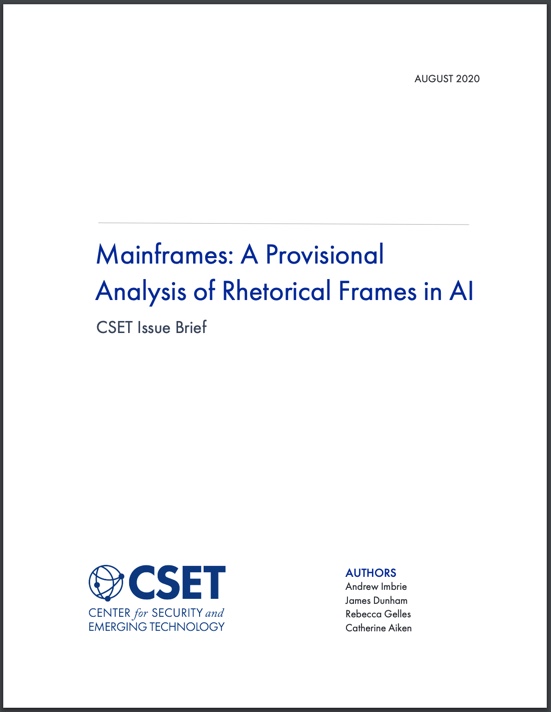When it comes to artificial intelligence, the headlines suggest that great powers are engaged in an AI arms race: “For Superpowers, Artificial Intelligence Fuels New Global Arms Race,” reads one story in Wired. 1 “China is Winning a New Global Arms Race,” observes Bloomberg Markets and Finance.2 One report in The Wall Street Journal asserts, “The New Arms Race in AI.”3 To what degree do these headlines accurately represent elite opinion about AI?
Framing technological competition as an “AI arms race” or “battle for supremacy” has implications for policy, security, and international cooperation.4 Maintaining U.S. leadership in strategic areas of artificial intelligence is an important policy objective, but AI is a general-purpose technology that enables a vast array of applications. The AI arms race narrative obscures more than it reveals about which applications deserve priority and how the United States can shape norms and standards to guide the development of AI and machine learning consistent with democratic principles.5 Perceptions of an arms race in AI could lead great powers to disregard investments in safety and security. Further, arms race dynamics may inhibit cooperation and increase the risk of miscalculation or misperception involving the use of AI-enabled platforms and capabilities.6
Are the great powers engaged in an AI arms race? Emerging patterns in mass communication provide insight. Opinion makers use language to influence the behavior of others and justify new investments and directions in policy.7 Public perceptions of AI shape the calculus of national leaders. Rhetorical framing of AI therefore serves as a barometer for both public and elite opinion, indicating whether attitudes are becoming more cooperative or competitive over time.
In this paper, we develop a novel methodology to explore the rhetorical framing of AI. We searched more than 4,000 English-language articles over the 2012 to 2019 period from the global news outlet Reuters, the U.S.-based Defense One, and Foreign Affairs and identified references to “AI competition.”8 This frame describes AI development as a race between two or more actors, such as governments or companies—whether in military or non-military terms. Invocations of the frame include the following:
- a military competition (“arms race”)
- historical competition (“Cold War” or “Sputnik Moment”)
- a territorial competition (“supremacy in Europe”)
- a competition for resources (“battle for talent”)
- any other type of competition (“two-man contest” or “AI rivalry”)
In addition to capturing occurrences of the frame over time, we identified the purpose for which it is invoked. We classified the purpose of the “competition” frame as motivation (for changing the status quo), explanation (of the state of the world), or critique (of the frame itself).
Our provisional findings are as follows:
- Since 2012, a growing number of articles in the three news sources have included the competition frame, but prevalence of the frame as a proportion of all AI articles peaked in 2015. Reporting on AI has become more sophisticated and diverse.
- The competition frame was predominantly used for explanation, though an increasing share of articles invoked it for motivation or critique. The purpose seems closely related to the source: motivation and critique were more common in Defense One, which features analysis and opinion pieces together with news, than in Reuters, a news agency.
- In the United States, individuals most frequently associated with use of the frame for motivational purposes came from the tech sector, the U.S. Senate, and the U.S. Department of Defense.
- Internationally, the institutional affiliations most frequently connected with use of the frame for motivational purposes were the French and Russian governments.
- The companies most frequently associated with the frame were from the United States, Japan, Finland, India, and China.
Download full issue brief
Mainframes: A Provisional Analysis of Rhetorical Frames- Tom Simonite, “For Superpowers, Artificial Intelligence Fuels New Global Arms Race,” Wired, August 8, 2017, https://www.wired.com/story/for-superpowers-artificial-intelligence-fuels-new-global-arms-race/.
- “China is Winning a New Global Arms Race,” Bloomberg Markets and Finance, November 6, 2018, https://www.youtube.com/watch?v=1Nr6daj4rBA.
- Julian E. Barnes and Josh Chin, “The New Arms Race in AI,” Wall Street Journal, March 2, 2018, https://www.wsj.com/articles/the-new-arms-race-in-ai-1520009261.
- Stuart Armstrong, Nick Bostrom, and Carl Shulman, “Racing to the Precipice: A Model of Artificial Intelligence Development,” AI & Society 31 (2016): 201-206; Remco Zwetsloot, Helen Toner, and Jeffrey Ding, “Beyond the AI Arms Race America, China, and the Dangers of Zero-Sum Thinking,” Foreign Affairs, November 16, 2018, https://www.foreignaffairs.com/reviews/review-essay/2018-11-16/beyond-ai-arms-race; Elsa B. Kania, “The Pursuit of AI Is More Than an Arms Race,” Defense One, April 19, 2018, https://www.defenseone.com/ideas/2018/04/pursuit-ai-more-arms-race/147579/; Crispin Rovere, “Explained: The Artificial Intelligence Race is an Arms Race,” The National Interest, February 2, 2020, https://nationalinterest.org/blog/buzz/explained-artificial-intelligence-race-arms-race-119326.
- Heather M. Roff, “The Frame Problem: The AI “Arms Race” Isn’t One,” Bulletin of Atomic Scientists 75, Issue 3 (2019): 2019; Tim Hwang and Alex Pascal, “Artificial Intelligence Isn’t an Arms Race,” Foreign Policy, December 11, 2019.
- Andrew Imbrie and Elsa Kania, “AI Safety, Security, and Stability Among Great Powers: Options, Challenges, and Lessons Learned for Pragmatic Engagement,” Center for Security and Emerging Technology, December 2019, https://cset.georgetown.edu/wp-content/uploads/AI-Safety-Security-and-Stability-Among-the-Great-Powers.pdf.
- On the role of narratives and legitimation strategies in national security, see e.g., Ronald R. Krebs, Narrative and the Making of US National Security (Cambridge: Cambridge University Press, 2015); Stacie E. Goddard and Ronald R. Krebs, “Rhetoric, Legitimation, and Grand Strategy,” Security Studies 24, Issue 1 (2015): 5-36.
- Our 4,000 articles are English-language articles from three different news outlets; one global news outlet, Reuters, and two U.S. news outlets, Defense One and Foreign Affairs.
